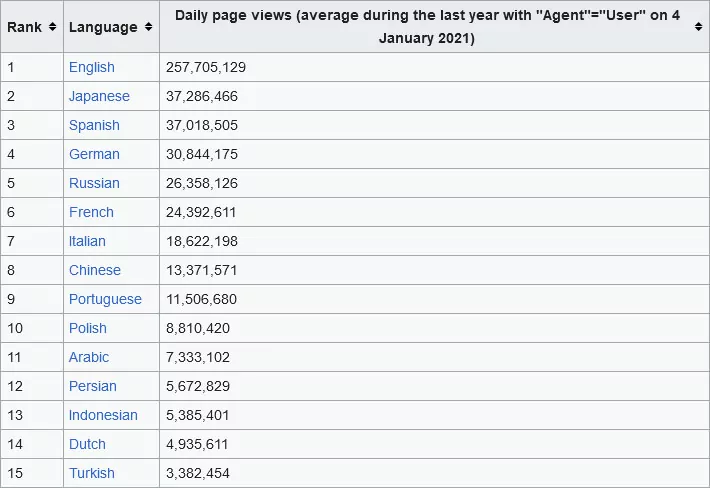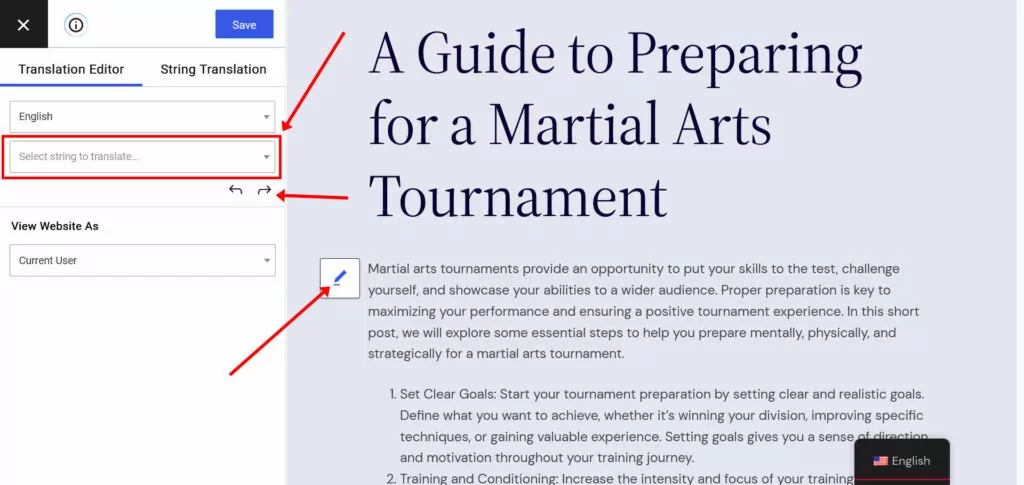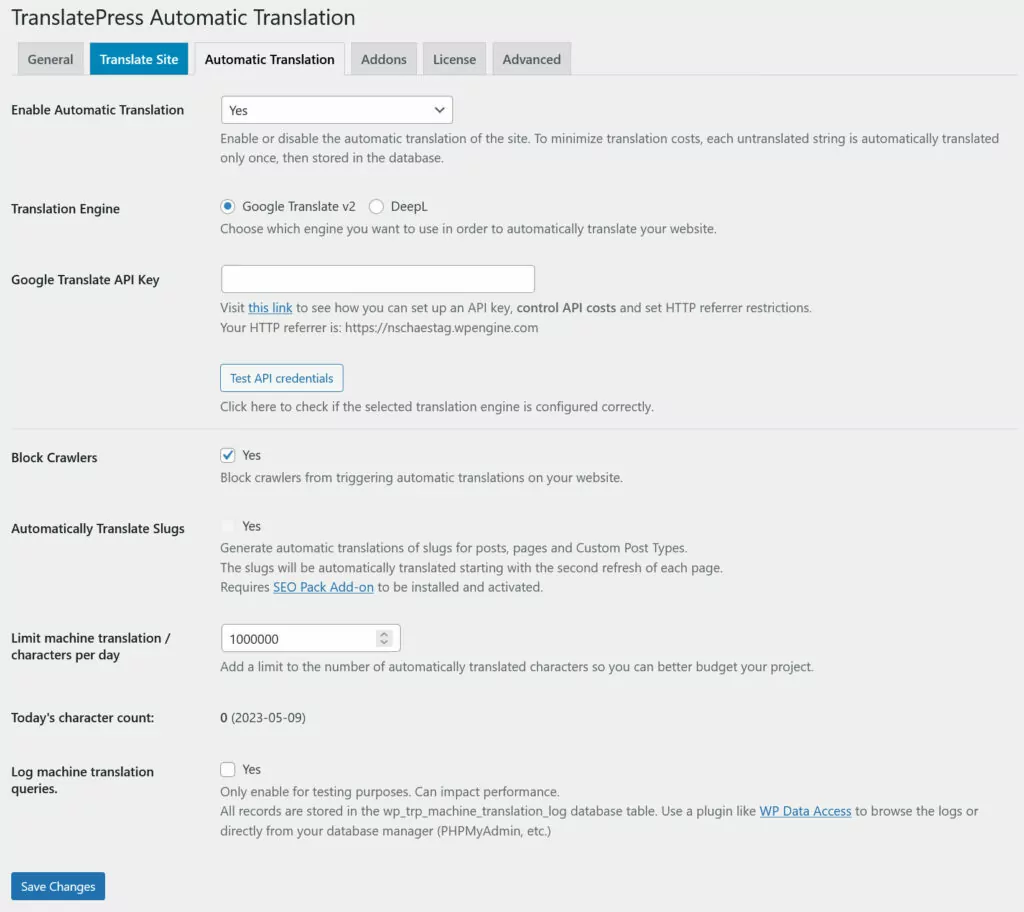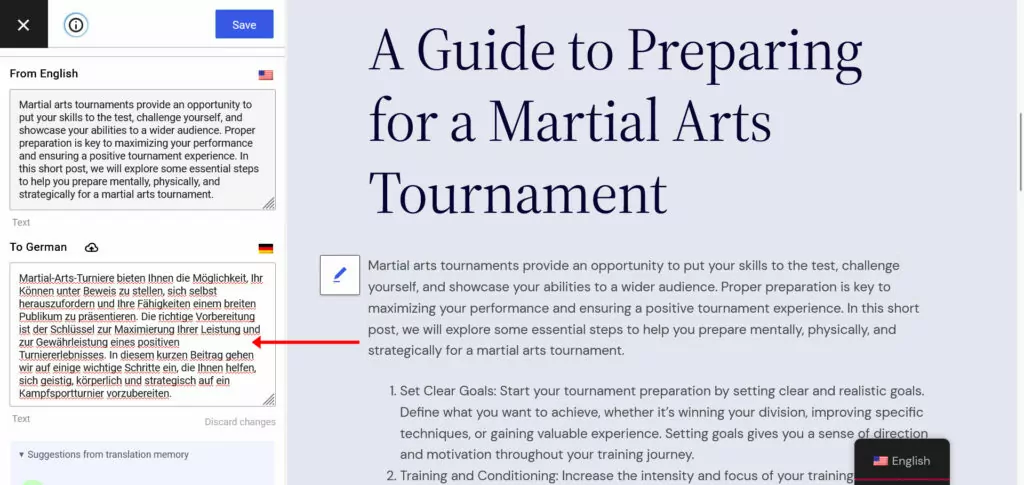Knowing the most used languages on the Internet and most commonly spoken languages in the world is important information when deciding what to translate your website into. It can give you pointers about which languages it makes sense to adopt and which not.
After all, there are many benefits to making your site multilingual. It can lead to more traffic, increased sales, better conversions, and higher consumer trust. However, which languages should you convert your website into to achieve that? What languages would allow you to effectively reach the most people?
To help answer these questions, in this post, we will examine the top spoken languages in the world and on the Internet (as you will see, these are not always the same). You’ll learn what languages have the most native speakers and how that reflects on their use in online content.
However, choosing a language for your website translation depends on more than just raw numbers. For that reason, we will also discuss factors you should additionally consider when adding new languages to your site. Finally, we’ll recommend a way to implement the localization of your website in the easiest way.
What Are the Most Spoken Languages in the World and Online?

To start off, let’s examine what languages have the most native speakers in the world. After that, we will examine how that relates to the most used languages on the Internet.
The Top 10 Spoken Languages in the World
Here are the most commonly spoken languages in the world. The list below is based on information from Wikipedia, which pulled its data from Ethnologue.
- Globally, Mandarin Chinese is the most used language with 939 million native speakers. Not a big surprise seeing as China is the second most populous country in the world and Mandarin its official language.
- In second place comes Spanish, with 485 million. This, too, is not surprising. There is a multitude of countries that claim it as their native tongue, especially in South America.
- English goes for third place. That’s especially thanks to the USA, which provide more than 300 of the 380 million native speakers.
- In fourth place is Hindi, one of the most spoken languages in India (345 million people speak it ). India is actually the country with the most inhabitants, however, because it’s broken down into several different languages, none of them claim the top spot.
- Portuguese is the fifth most spoken language in the world. Here, too, we have South America to thank. Brazil provides some 200 of the overall 236 million native Portuguese speakers.
- On rank six is another language from the Indian subcontinent, Bengali. 234 million people speak it, mostly in Bangladesh, where it’s the main language, and the Eastern part of India.
- Number seven is Russian, which has 147 million speakers. As the biggest country in the world and a corresponding population, it’s natural that it breaks into the top ten.
- Our number eight is Japanese with 123 million native speakers. Though relatively small, Japan is a densely inhabited country, which is why it places high up in the world’s most spoken languages.
- Yue Chinese including Cantonese comes ninth. It’s a group of Chinese dialects mostly spoken in the South of China. However, mind you, there are still 86.1 million people claiming it as their native tongue.
- Finally, at number ten is Vietnamese with 85 million speakers. Fun fact, Vietnamese is also spoken in a small region of Southern China.
Places 11-20
Who are the runner-ups? Let’s go over them real quick:
- Turkish (84 million speakers)
- Wu Chinese (e.g. Shanghainese, 83.4 million)
- Marathi (spoken mostly in the Maharashtra region of India, 83.2 million)
- Telugu (83 million speakers, another Indian language native to Andhra Pradesh and Telangana)
- Korean (81.7 million speakers)
- French (80.8 million)
- Tamil (spoken in the Indian state Tamil Nadu, Sri Lanka, Singapore, and others by 78.6 million people)
- Egyptian Arabic (77.4 million)
- Standard German (there are 75.3 million of us)
- Urdu (70.6 million speakers, mostly in Pakistan and India)
Contrast That With the Most Dominant Languages in Online Content
So, from the above it seems like if you want to reach the biggest possible audience, you simply translate your site to Chinese, English, and Spanish, right? Job done.
However, it’s not as simple as that.
For one because, as we will see below, there are some languages that we haven’t even covered yet. In addition, just because a lot of people speak a particular language, that doesn’t mean it makes sense to offer it on your website. Finally, the language distribution on the Internet is not the same as in the real world. In fact, it’s very different. Check out the share of languages in online content according to W3Techs below.

As you can see, English is absolutely dominating with almost 54% of all online content. In comparison, in worldwide languages, its share is really only about 5%. Next up are Spanish and Russian with only about 5% each. In the real world, they make up 6% and 2% of the world’s most spoken languages respectively.
German, which didn’t even crack the top ten earlier can be found in fourth place. In addition, Germany’s country-specific domain ending is the fifth most common in the world.

On the other hand, Chinese, which, as we remember, is the language with the most native speakers, is only on rank 13 with a 1.4 % share of online content.
Curious, isn’t it?
Most Commonly Used Languages on Popular Websites
Yet, the trend towards English as the dominant language for online content continues when you look at individual popular websites. A good example of that is YouTube, or the “second most popular search engine in the world”. An analysis of the 250 most popular YouTube channels showed that 66% are in English, 15% in Spanish, 7% in Portuguese, 5% in Hindi, and 2% in Korean.

It’s not clear from when these numbers are and YouTube doesn’t publish official numbers for this but it’s an interesting snapshot. Plus, Alan Spicer comes to similar conclusions.

Another example is Wikipedia. They have a breakdown of daily traffic for the different language versions of their site.

Here, too, English is the front runner, interestingly followed by Japanese, then Spanish, then German. As you can see, language preference also changes according to content type, however, English is always in the lead.
So, Does Everyone on the Web Simply Speak English?
If you are perplexed about the difference in language distribution online and in real life, we’ll get into the reasons for it further below. However, one decisive factor is also where you get your data from.
For example, the information from W3Techs above is based on the top 10 million websites worldwide, which likely skew heavily towards English. Things look a bit different if you take the numbers from InternetWorldStats, which estimate total global Internet users by language in 2020.

Here, too, English reigns supreme. Yet, it is much more closely followed by Chinese, then Spanish, and Arabic, which we hadn’t even discussed yet. Besides that, it’s surprising to see Indonesian/Malaysian in the mix as well as French and German in the top ten Internet languages.
The reason why Arabic didn’t appear earlier is that it consists of many dialects, which can be very different from one another. That’s why other sources don’t count it as one language. At the same time, written Arabic does not vary in the same way. Therefore, in (written) online content, you can count it as one.
You will also notice that the English-speaking world population is given as more than 1.5 billion even though we just learned that there are only around 380 million native speakers. It seems that there are a lot of other people who use English as their primary online language.
Finally, what’s interesting to note is that different languages still have different amounts of people to add to the pool of Internet users. For example, while Japanese speakers are at almost 100% Internet penetration, their Chinese counterparts still have literally hundreds of millions of people to add to their ranks.
That means, in the long run, Chinese could actually be the dominant language of the web, at least by the number of speakers. To catch up in terms of available content, it still has a ways to go. We have to keep in mind though that these numbers are three years old, so things are probably a bit different now.
What Does This All Mean for Your Website?
The question is, what do we learn from the above? First of all, English is clearly the dominant language of the Internet. That’s not a big surprise since it’s what the web was originally built on and, therefore, has had a head start. Plus, it’s the world’s universal language. There are loads of non-English native speakers who are nevertheless consuming and producing content in that language (such as me).
That also means that, if your website is currently in another language, English is a good choice for you to translate it into. Doing so will give you the most bang for your buck. It allows you to target a large and diverse audience, not just native speakers.
TranslatePress Multilingual
TranslatePress is the easiest way to translate your WordPress site. It's fast, won't slow down your website, works with ANY theme or plugin and it's SEO friendly.
Get the pluginAnother main takeaway is that real-world popularity does not translate to the online audience. German is a globally relatively small language but has a comparatively large presence online. This is something to be aware of when deciding what to translate your website into.
One of the main reasons for that is likely Internet access, which differs between language groups. This can be both due to simply a lack of technical infrastructure or because there are other obstacles in place. For example, YouTube is blocked in China. Therefore, you will have a hard time finding channels from the mainland on the platform. Depending on what your website is about, this could be relevant.
Finally, there are still a number of emerging language markets. Chinese, Arabic, Portuguese, and French will all be adding users to the Internet in the coming years. This means, if you are an early adopter, it can give you an edge business. You may be able to establish yourself before others jump on the same language trend and also possibly break into a less saturated market.
How to Pick Which Languages to Translate Your Website Into
That leaves the question, should you simply choose languages to add to your website due to the sheer number of people who speak them? Of course not. The decision tree for that is more complex. Let’s discuss other important factors to consider.
Clarify Your Target Group
The first step when considering making changes to your website is always to go back to your target group. Who exactly are you trying to attract and talk to with your site? In the end, it doesn’t matter if the languages you offer are the most used on the Internet if your target audience doesn’t speak them.
For example, when doing business in Iceland, your visitors couldn’t care less if your website is in Chinese, even if it’s statistically the most spoken language in the world. On the other hand, as a hospitality business near any tourist hotspot in Europe, Mandarin can be a good choice since the Chinese are world champions in traveling.

On the other hand, if you are a local coffee shop operating in a city that has a lot of expats (like Berlin), adding English to your website can be a good idea to attract more customers.
Simply put, just like your website content, you need to align your website translation with your intended target group. It depends on more than simply the number of speakers you can reach. If you add a language to your site, you should have a good reason for it.
Examine the Markets You Are Operating In
In addition to your target group, the market that your business operates in can already provide some guidelines for the choice of language on your site.
If you offer your services globally, going for the most spoken languages in the world in descending order can actually be a way to go. This allows you to cover the most ground and bring in additional traffic. On the other hand, if your market is strictly local, this approach doesn’t make sense.
What’s more, the location of your business can actually dictate your website languages. There are several countries in the world where you need to offer more than one language out of the box. For example, in Spain, besides Spanish, you would be well advised to also provide your website in Catalan, Galician, and/or Basque.

A website operating in Switzerland needs three languages: French, Italian, and German.

However, it’s not just something for when your locality forces more than one language upon you. It can also be a conscious decision in order to start exploring and serving new buyers.
Translating your site into the languages of neighboring countries can be a good way to attract business from there. First of all, doing so will allow your site to show up for relevant search queries in those languages. Secondly, it’s a big factor in purchase decisions. For many people, the ability to get information in their mother tongue is an important trust factor.
Check Your Analytics and Traffic
Another consideration for translating your website is visitor language. A language might be one of the most used in the world or even on the Internet, but is it what your audience speaks?
To answer that question, you’d do well to turn to your website analytics. In Google Analytics and other such solutions, you can see a map of where your visitors are from and also the language settings of their browsers.

This can greatly help you make decisions about what language it makes sense to offer on your site. If you don’t offer their language currently but people from that country still visit your site, just imagine how many would come if you communicated in their mother tongue.
Other sources for this kind of information can be keywords in webmaster tools, support inquiries, or messages on social media.
Do a Competitor Analysis
Another way to get ideas about which of the world’s most spoken languages is probably a good idea to have on your site is to look at your competition. Check the web presence of your closest competitors and see what languages they include. Oftentimes, they are there for a good reason. Your competitors might know something you don’t.
Sure, you still need to make your own decisions, however, checking on others can give you an inkling about what languages could help you get more visitors, sales, and conversions. It allows you to capitalize on other people’s success and research.
Consider Design and Cost Limitations
Finally, when looking at the most common languages on the Internet and deciding whether to add one or more to your site, you need to consider your site design and the cost involved.
Why is the design important?
Because not all design is easy to convert to every language. For example, some languages are more verbose, meaning they need more or longer words to say the same thing as others. On the other hand, character-based languages like Chinese, Japanese, and Korean tend to need a lot less space as they can express more information in a condensed way.

In addition, some languages go from right to left instead of the other way around. Arabic is one such example, and Hebrew is another. Either can mess up your layout because of different space requirements and you need to find a solution for that.
If you want to offer a language that’s very different from your original, you might need a whole different website design and layout. Are you prepared to create that? Does that make sense for the amount of extra traffic that this language will likely bring in?
Finally, some languages are cheaper to translate into than others. Spanish and English have a large pool of capable translators, other, less popular, or more complicated languages not so much. These are all important considerations.
Use TranslatePress to Translate Your Website Into Common Languages
Looking at the most spoken languages is a good start to start thinking about what to add to your WordPress website. However, once you have made a decision, it’s just as important that you have a good tool to implement them. At this point, we want to humbly suggest TranslatePress as that tool, and here is why.
Easy-to-Use Interface
In TranslatePress, most of the translation work happens in the same easy interface. It contains a preview of your site on the right while you do all the translating on the left.

Use the preview to navigate to the page you want to convert to another language. Then, choose any of the strings on it either via the drop-down menu, left and right arrows, or directly from the page.

This will open up a new text box on the left where you can add the translation. When done, simply save it and from now on the translated text will appear on your website.

Possibility to Translate Images
In addition to the above, TranslatePress also allows you to localize your images. This is especially important when you use text in your visuals. However, it can also make sense to use a whole other image for another region, especially to better represent the ethnicity of different regions.

Either way, in TranslatePress you can also select an image for translation from the interface and then provide an alternative on the left. It will appear automatically in the same way as your translated text.

Automatic Translation Options
In addition, TranslatePress offers automatic translations via Google Translate and DeepL (note that you need a license for the second option). Simply switch it on under Settings → TranslatePress → Automatic Translation, then acquire and paste an API key, save, and that’s mostly it.

With automatic translation enabled, when working in the translation interface and choosing a string, you will automatically find the equivalent there.

This is perfect for translating your website more quickly and also for any translation that doesn’t have to be perfect. Automatic translation is not as accurate as manual translation but can still be enough in a pinch.
Multilingual SEO
Finally, TranslatePress comes with a multlingual SEO pack (available in the premium version). This allows you to translate your page links, SEO titles, meta descriptions, ALT tags, and other important SEO markers.

It also creates multilingual sitemaps to submit to search engines and works with most popular WordPress SEO plugins. All of this help you to actually show up for search requests in your translated languages.
What Popular Internet Languages Will You Translate Your Site Into?
Knowing which languages are most spoken in the world and online is a good starting point when considering what to translate your website into. After all, when you add a language to your site that a lot of people speak, you can potentially reach hundreds of millions of additional visitors.
However, language popularity is just one factor to consider. As we have seen above, a lot more goes into what additional languages make sense on your site. Just because some are part of the top spoken languages in the world, it doesn’t mean they make sense for your particular Internet business or website. Use the guidelines above to come to a decision for yourself, then add TranslatePress to make it a reality.
TranslatePress Multilingual
TranslatePress is the easiest way to translate your WordPress site. It's fast, won't slow down your website, works with ANY theme or plugin and it's SEO friendly.
Get the pluginWhat’s your process for choosing languages to translate your site into? Tell us in the comments below!


